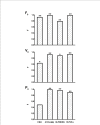Muscle Force-Velocity Relationships Observed in Four Different Functional Tests
- PMID: 28469742
- PMCID: PMC5384051
- DOI: 10.1515/hukin-2017-0021
Muscle Force-Velocity Relationships Observed in Four Different Functional Tests
Abstract
The aims of the present study were to investigate the shape and strength of the force-velocity relationships observed in different functional movement tests and explore the parameters depicting force, velocity and power producing capacities of the tested muscles. Twelve subjects were tested on maximum performance in vertical jumps, cycling, bench press throws, and bench pulls performed against different loads. Thereafter, both the averaged and maximum force and velocity variables recorded from individual trials were used for force-velocity relationship modeling. The observed individual force-velocity relationships were exceptionally strong (median correlation coefficients ranged from r = 0.930 to r = 0.995) and approximately linear independently of the test and variable type. Most of the relationship parameters observed from the averaged and maximum force and velocity variable types were strongly related in all tests (r = 0.789-0.991), except for those in vertical jumps (r = 0.485-0.930). However, the generalizability of the force-velocity relationship parameters depicting maximum force, velocity and power of the tested muscles across different tests was inconsistent and on average moderate. We concluded that the linear force-velocity relationship model based on either maximum or averaged force-velocity data could provide the outcomes depicting force, velocity and power generating capacity of the tested muscles, although such outcomes can only be partially generalized across different muscles.
Keywords: generalizability; load; output; parameter; power.
Figures



Similar articles
-
Is Test Standardization Important when Arm and Leg Muscle Mechanical Properties are Assessed through the Force-Velocity Relationship?J Hum Kinet. 2019 Oct 18;69:47-58. doi: 10.2478/hukin-2019-0010. eCollection 2019 Oct. J Hum Kinet. 2019. PMID: 31666888 Free PMC article.
-
A simple method for assessment of muscle force, velocity, and power producing capacities from functional movement tasks.J Sports Sci. 2017 Jul;35(13):1287-1293. doi: 10.1080/02640414.2016.1221521. Epub 2016 Aug 19. J Sports Sci. 2017. PMID: 27541062
-
Are the Parameters of Novel Two-Point Force-Velocity Model Generalizable in Leg Muscles?Int J Environ Res Public Health. 2021 Jan 25;18(3):1032. doi: 10.3390/ijerph18031032. Int J Environ Res Public Health. 2021. PMID: 33503856 Free PMC article.
-
Force-velocity Relationship of Muscles Performing Multi-joint Maximum Performance Tasks.Int J Sports Med. 2015 Aug;36(9):699-704. doi: 10.1055/s-0035-1547283. Epub 2015 Mar 25. Int J Sports Med. 2015. PMID: 25806588 Review.
-
Muscle mechanics: adaptations with exercise-training.Exerc Sport Sci Rev. 1996;24:427-73. Exerc Sport Sci Rev. 1996. PMID: 8744258 Review.
Cited by
-
Isokinetic Testing: Sensitivity of the Force-Velocity Relationship Assessed through the Two-Point Method to Discriminate between Muscle Groups and Participants' Physical Activity Levels.Int J Environ Res Public Health. 2020 Nov 19;17(22):8570. doi: 10.3390/ijerph17228570. Int J Environ Res Public Health. 2020. PMID: 33227905 Free PMC article.
-
Effects of Resistance Training With Constant, Inertial, and Combined Loads on Muscle Power and Strength Output.Front Physiol. 2021 Nov 25;12:709263. doi: 10.3389/fphys.2021.709263. eCollection 2021. Front Physiol. 2021. PMID: 34899366 Free PMC article.
-
Directional Dependence of Experimental Trunk Stiffness: Role of Muscle-Stiffness Variation of Nonneural Origin.Appl Bionics Biomech. 2020 Dec 9;2020:8837147. doi: 10.1155/2020/8837147. eCollection 2020. Appl Bionics Biomech. 2020. PMID: 33488765 Free PMC article.
-
Assessing the Maximal Mechanical Capacities Through the Load-Velocity Relationship in Elite Versus Junior Male Volleyball Players.Sports Health. 2024 Sep-Oct;16(5):829-836. doi: 10.1177/19417381231208706. Epub 2023 Nov 10. Sports Health. 2024. PMID: 37950435 Free PMC article.
-
Is Test Standardization Important when Arm and Leg Muscle Mechanical Properties are Assessed through the Force-Velocity Relationship?J Hum Kinet. 2019 Oct 18;69:47-58. doi: 10.2478/hukin-2019-0010. eCollection 2019 Oct. J Hum Kinet. 2019. PMID: 31666888 Free PMC article.
References
-
- Allison SJ, Brooke-Wavell K, Folland JP.. Multiple joint muscle function with ageing: the force-velocity and power-velocity relationships in young and older men. Aging Clin Exp Res. 2013;25:159–66. - PubMed
-
- Bohannon RW.. Hand-grip dynamometry predicts future outcomes in aging adults. J Geriatr Phys Ther. 2008;31:3–10. - PubMed
-
- Cohen J.. Statistical power analysis for the behavioral sciences. Statistical Power Analysis for the Behavioral Sciences. 1988;567
LinkOut - more resources
Full Text Sources
Other Literature Sources
